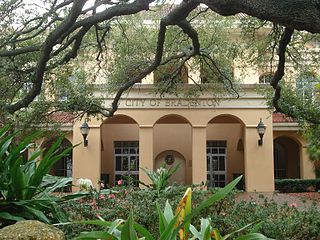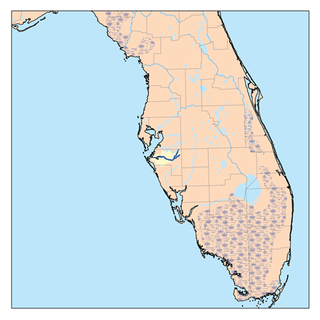
The grapefruit is a subtropical citrus tree known for its relatively large sour to semi-sweet, somewhat bitter fruit. Grapefruit is a citrus hybrid originating in Barbados as an accidental cross between two introduced species – sweet orange, and pomelo – both of which were introduced from Asia in the seventeenth century. When found, it was nicknamed the "forbidden fruit". Frequently, it is misidentified as the very similar parent species, pomelo.
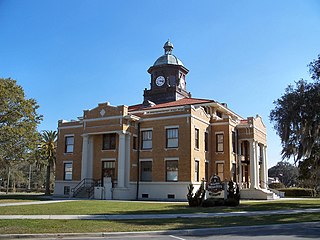
Citrus County is a county located in the U.S. state of Florida. As of the 2010 census, the population was 141,236. Its county seat is Inverness, and its largest community is Homosassa Springs.

Temple Terrace is an incorporated city in northeastern Hillsborough County, Florida, United States, adjacent to Tampa. As of the 2010 census, the city had a population of 24,541. It is the third and smallest incorporated municipality in Hillsborough County. Incorporated in 1925, the community is known for its rolling landscape, bucolic Hillsborough River views, and majestic trees; it has the most grand sand live oak trees of any place in central Florida and is a Tree City USA. Temple Terrace was originally planned as a 1920s Mediterranean-Revival golf course community and is one of the first such communities in the United States.

Sarasota–Bradenton International Airport is located within three jurisdictions: Sarasota County, the city limits of Sarasota, and Manatee County. Owned by the Sarasota Manatee Airport Authority, it is 3 miles (4.8 km) north of downtown Sarasota and 6 miles (9.7 km) south of Bradenton.

Citrus fruits are the highest-value fruit crop in terms of international trade. There are two main markets for citrus fruit:

Minute Maid is a product line of beverages, usually associated with lemonade or orange juice, but which now extends to soft drinks of many kinds, including Hi-C. Minute Maid is sold under the Cappy brand in Central Europe and under the brand "Моя Семья" in Russia and the Commonwealth of Independent States. Minute Maid was the first company to market orange juice concentrate, allowing it to be distributed throughout the United States and served year-round. The Minute Maid Company is owned by The Coca-Cola Company, the world's largest marketer of fruit juices and drinks. The firm opened its headquarters in Sugar Land Town Square in Sugar Land, Texas, United States, on February 16, 2009; previously it was headquartered in the 2000 St. James Place building in Houston.

The 1944 Cuba–Florida hurricane was a large Category 4 tropical cyclone that caused widespread damage across the western Caribbean Sea and Southeastern United States in October 1944. It inflicted over $100 million in damage and was responsible for at least 318 deaths, with the majority of fatalities occurring in Cuba. One study suggested that an equivalent storm in 2018 would rank among the costliest U.S. hurricanes, with a damage toll approaching that of Hurricane Sandy. However, the full extent of the storm's effects remains unclear due to a dearth of conclusive reports from rural areas of Cuba. The unprecedented availability of meteorological data during the hurricane marked a turning point in the United States Weather Bureau's ability to forecast tropical cyclones.
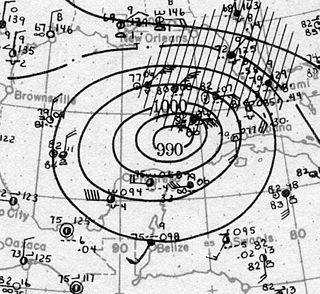
The Tampa Bay hurricane of 1921 is the most recent major hurricane to strike the Tampa Bay Area. The eleventh tropical cyclone, sixth tropical storm, and fifth hurricane of the season, the storm developed from a trough in the southwestern Caribbean Sea on October 20. Initially a tropical storm, the system moved northwestward and intensified into a hurricane on October 22 and a major hurricane by October 23. Later that day, the cyclone peaked as a Category 4 on the modern day Saffir–Simpson scale with maximum sustained winds of 140 mph (220 km/h). After entering the Gulf of Mexico, the hurricane gradually curved northeastward and weakened to a Category 3 before making landfall near Tarpon Springs, Florida, late on October 25, becoming the first major hurricane to hit the area since a hurricane in 1848. The storm quickly weakened to a Category 1 hurricane while crossing Central Florida, before reaching the Atlantic Ocean early on the following day. Thereafter, system moved east-southeastward and remained fairly steady in intensity before weakening to a tropical storm late on October 29. The storm was then absorbed by a larger extratropical cyclone early the next day, with the remnants of the hurricane soon becoming indistinguishable.
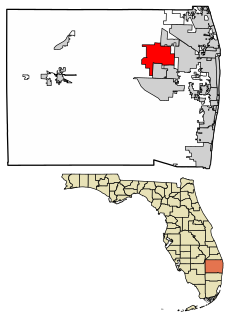
The Acreage is an unincorporated community located in Palm Beach County, Florida, United States, with a 2010 US Census Bureau population count of 38,704. It is located in the areas north of Royal Palm Beach and Loxahatchee Groves, and is approximately 15 miles (24 km) northwest of West Palm Beach. Most of the population lives in single-family homes on 1.14 acres (4,600 m2) and larger lots. It straddles the western fringes of the highly developed eastern portion of Palm Beach County and the agricultural-rural western portions. Its large, spacious home site lots, dirt roads and many wooded areas give the area a rural character, although it is widely considered to be an exurban outgrowth of the South Florida Metropolitan Area. The Acreage is located solely within the Indian Trail Improvement District, responsible for maintaining the road and drainage systems within its boundaries.
The Great Freeze refers to the back-to-back freezes of 1894–1895 in Florida, where the brutally cold weather destroyed much of the citrus crop. It may also have been responsible for wiping out natural stands of Royal Palm trees from the lower St. Johns River Valley northeast of Orlando.
Friends of Seagate Inc. was founded in the late 1980s by Kafi Benz as a 501(c)(3) nonprofit organization in Sarasota, Florida. The historic preservation group lead local efforts protect historic property in the Sarasota-Bradenton area from commercial development. The group later expanded its scope to include environmental conservation. Its most notable project was the preservation of Seagate, the former home of Cincinnati, Ohio, industrialist Powel Crosley Jr. and his wife, Gwendolyn, and its later owners, Mabel and Freeman Horton. In 2002 the organization tried to secure Rus-in- Ur'be, an undeveloped parcel of land in the center of the Indian Beach Sapphire Shores neighborhood, as a local park; however, as of 2014, real estate developers intend to build condominium units at the site.

The Florida Maritime Museum (FMM) is a museum, sponsored by Manatee County Clerk of Circuit Courts, located on 4 acres (1.6 ha) of land within the historic fishing village of Cortez, Florida.

Manavista was an area surrounded by the Atwood Grape Fruit Company. The brief history of Manavista began when Kimball C. Atwood (1853-1934) purchased 265 acres of land that was situated a mile east of the city of Palmetto on the north side of the Manatee River in 1892. The grove consisted of about 96 rows of grapefruit trees. Atwood had an estate across the river in the town of Manatee. The winters of 1894 and 1895 were particularly severe and devastated the citrus industry in the state, driving the citrus belt further southward. It wasn't until 1897 that Atwood was able to procure new trees from the Reasoners, who owned and operated a plant nursery, had recently received them in stock. Grapefruit varieties included Duncan, Royal, and Walter. A post office opened in 1898 with the name "Manavista" attached, under the supervision of its first postmaster, Lewis C. Randall.

Manhattan was a proposed city in a development that was located in northern Manatee County, Florida near the present-day town of Parrish during the Florida land boom in the 1920s. The town was intended to be the centerpiece of an agricultural community called Manatee River Park Estates.

Verna is an unincorporated area in Manatee County and Sarasota County, Florida, United States.
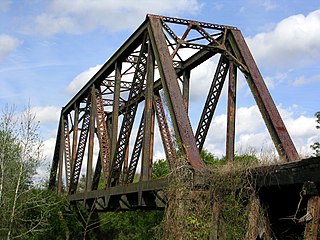
Willow is a ghost town in Manatee County, Florida, United States.
Limoneira is a public limited agribusiness and real estate development company based in Santa Paula, California, United States. The Company's operations mainly consist of production, sales and marketing of citrus and avocados They have three business segments which are agribusiness, rental operations and real estate development. The company received the IPM Innovator Award at California Legislature Assembly Resolution.
Alico, Inc. is a holding company which owns Alico Citrus, the nation’s largest citrus producer, and Alico Water Resources, a leading water storage and environmental services company. Alico, Inc. also owns major land holdings in Florida.

Seagate, also known as the Bay Club, is located along Sarasota Bay in Manatee County, Florida, and was the former winter estate of Powel Crosley Jr., a noted Cincinnati, Ohio, industrialist and entrepreneur. Crosley had the 11,000-square-foot (1,000 m2), Mediterranean Revival-style home built in 1929 for his wife, Gwendolyn, on 45-acre (18-hectare) of land along Sarasota Bay that was platted in 1925 for a failed subdivision. New York architect George Albree Freeman Jr. designed the home; Ivo A. de Minicis, a Tampa, Florida, architect, drafted the plans; and Paul W. Bergmann, a Sarasota contractor, reportedly built the two-and-a-half story, cast stone and stucco home in 135 days. Gwendolyn Crosley died at Seagate in 1939. After allowing the Army Air Corps to use the home for airmen who were training at a nearby airbase during World War II, Crosley sold the property in 1947. Freeman Horton and his wife, Mabel, bought it the following year. The Horton family lived on the estate from 1948 to 1977. The Campeau Corporation of America acquired the property in the early 1980s, intending to develop it into condominium units and use the residence serving as the development's clubhouse, but its plans failed. The Crosley home and 45 acres of adjacent property were formally added to the National Register of Historic Places on January 21, 1983.





